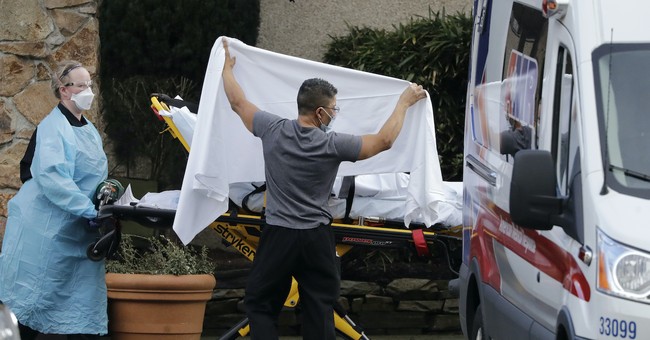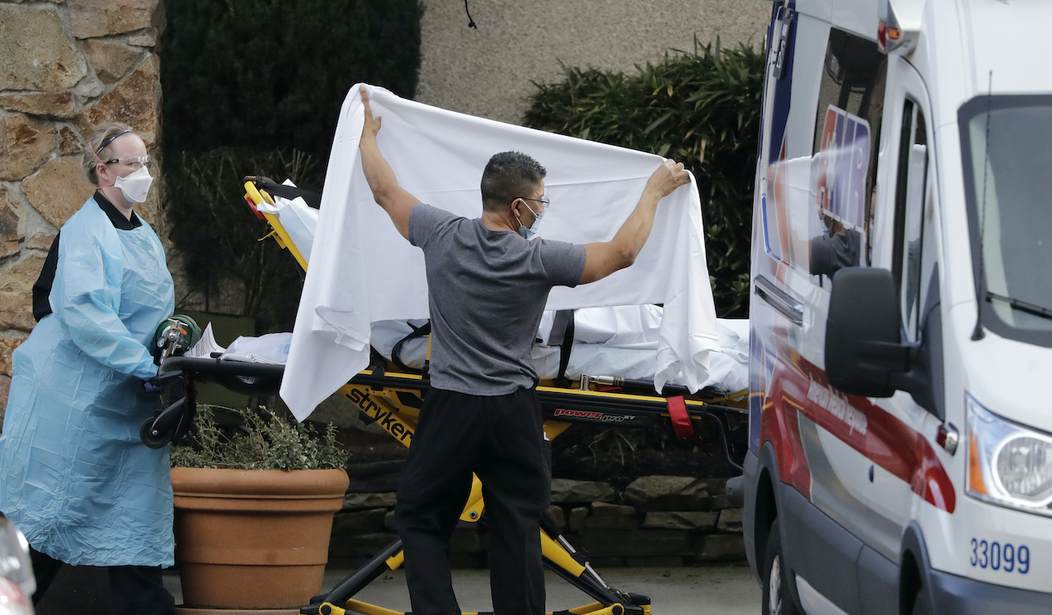
A staff member blocks the view as a person is taken by a stretcher to a waiting ambulance from a nursing facility where more than 50 people are sick and being tested for the COVID-19 virus, Saturday, Feb. 29, 2020, in Kirkland, Wash. (AP Photo/Elaine Thompson)
At the start of the Wuhan coronavirus saga, people were talking about a 3.4 percent mortality rate.
That caused some justifiable consternation. But what many weren’t considering was that number likely would drop as more diagnosed cases came in.
As I reported at the end of last week, the number of cases diagnosed in the U.S. would likely surge this week with an increase in testing, but that as a result, the mortality rate would drop and show that it was much less than the scary number being thrown out there.
If you look at the Worldometer measure, that’s exactly what has happened.
Over the period from March 7 to March 20, the mortality rate number according to the Worldometer stats has dropped steadily as the diagnosed cases has risen, going from 4.3 percent over that time to 1.3 percent. The first number is the number of cases, the second the number of deaths, the third is the rate.
3/7
435/19/4.3
3/8
541/22/4.0
3/9
704/26/3.6
3/10
994/30/3.0
3/11
1301/38/2.9
3/12
1697/41/2.4
3/13
2247/49/2.1
3/14
2943/57/1.9
3/15
3680/68/1.8
3/16
4663/86/1.8
3/17
6411/109/1.7
3/18
9259/150/1.6
3/19
13789/207/1.5
3/20
19383/256/1.3
Again, that’s still just the folks deciding they need to go get tested, there are likely more asymptomatic/non-diagnosed folks out there who don’t even get tested because they may not even realize it. It’s also likely that real number is even lower, as Dr. Anthony Fauci noted in the New England Journal of Medicine. “the case fatality rate may be considerably less than 1%,” if we assume that “the number of asymptomatic or minimally symptomatic cases is several times as high as the number of reported cases.”
The global rate is at 4.1 with 11,832 deaths for 283, 738 cases. Every country’s rate has varied based on a variety of their own unique factors – from greater concentration of elderly (Italy) to early deployment of mitigation factors (South Korea). Italy has the worst acknowledged rate in the world, at 8.5 percent, 4032 deaths out of 47,021, South Korea one of the best at 1.1, with 102 deaths out of 8799 cases. Fortunately, we’re much closer to South Korea. China and Iran’s numbers are questionable and I’m willing to bet China’s rate surpasses Italy, which is why I said “acknowledged rate.”
As we have observed in other posts, part of the reason we may be on the better side of the equation is the early and continuing mitigation of restricting travel from China and then from Europe, and now the social distancing protocols, things that were not as quickly implemented in China and Italy. We also don’t have a national health system like Italy that was already overloaded and we are deploying extra resources to buttress up what we do have.
While we can’t necessarily count the “recovery” claimed in China because they lie, we can see that South Korea already appears to have hit the peak and “flattened the curve” starting a couple of weeks ago. Again, we can’t say at what point we may do that, but that’s positive to see as we look toward the future, that it might be on our horizon, with practicing proper hygiene guidance we’ve been given and doing our best not to infect those most at risk, the elderly and those with serious pre-existing conditions.
HT: National Review













Join the conversation as a VIP Member